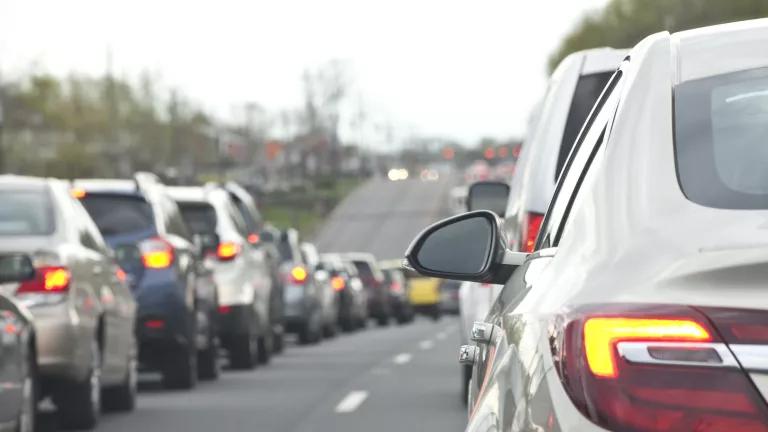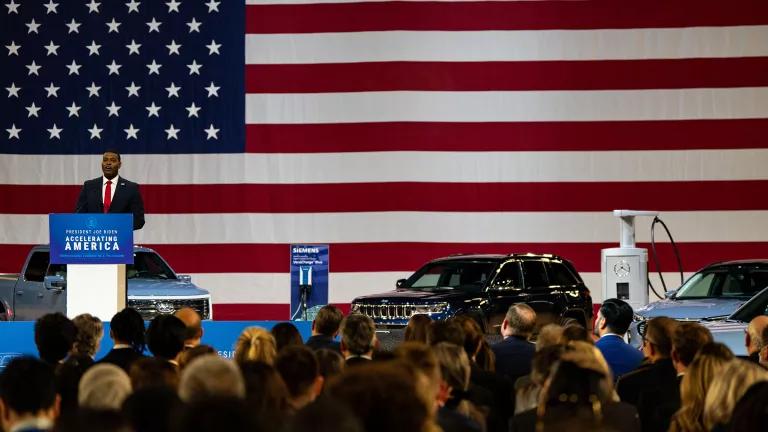New Jersey Can Lead on State Fleet Electrification
New Jersey’s transportation sector is responsible for 42% of the state’s greenhouse gas emissions, making it the state’s largest source of climate pollution; achieving the state’s climate goals will only be possible if New Jersey aggressively tackles transportation emissions head on.
This blog is the second in a series exploring the state of electric vehicle policy in New Jersey. The series takes a deep dive into the transportation electrification policies New Jersey will need to meet its ambitious climate laws. Together, they explore whether New Jersey needs more ambitious transportation electrification goals, the state’s existing plans to realize their goals, and the next steps New Jersey should take to decarbonize its transportation system. Ultimately, this blog series aims to holistically examine electrifying all segments of the transportation sector. Read the first blog here.
Leading By Example
New Jersey’s transportation sector is responsible for 42% of the state’s greenhouse gas emissions, making it the state’s largest source of climate pollution; achieving the state’s climate goals will only be possible if New Jersey aggressively tackles transportation emissions head on. While the state has made significant progress on several transportation initiatives around vehicle rebates and make-ready infrastructure, New Jersey needs a comprehensive plan to electrify the state’s own fleet vehicles if it is going to achieve the targets laid out in SB 2252 (“EV Law”).
The EV Law, passed in January 2020, signaled New Jersey’s commitment to reducing emissions from transportation. Among other requirements that support transportation electrification, the EV Law mandates aggressive action by the state to electrify 25 percent of its non-emergency light-duty state fleet by 2025, with that target increasing to 100 percent by 2035. The Energy Master Plan (EMP), New Jersey’s roadmap to meet its climate and clean energy goals, reiterates New Jersey’s commitment to rolling-over the state light-duty fleet to electric vehicles to help meet their climate goals.
While ambitious, these goals won’t actually do anything to curb emissions until New Jersey takes tangible steps to meet them. Governor Murphy can kick-start New Jersey’s electric future by directing the state to assess its fleet charging infrastructure, conduct annual fleet assessments and electrify the state’s fleet.
We recommend some immediate actions that New Jersey can take to begin electrifying the state fleet and encouraging state agencies to lead-by example.
A Roadmap to State Fleet Electrification
Charging Infrastructure
New Jersey needs to immediately begin building out charging infrastructure to support fleet EVs. To start, the state should issue a Request for Proposals for the procurement and installation of charging infrastructure, so that installation may begin as soon as agencies are ready. Concurrently, the state should assess all charging infrastructure that will be necessary to support the state’s 2025 electrification goals.
Moreover, the state should issue guidance on the installation of charging infrastructure, as well as streamlined charging station procurement. Since the process may vary by agency, state guidance would assist agencies in making smart decisions in a timely manner. The guidance should address common questions like how to minimize costs and grid impacts and when the charging stations could be used for public use.
Electric Vehicles
While agencies need proper charging infrastructure in place before widespread electric vehicles can enter into the market, the state should not wait for all charging infrastructure to be installed before thinking about purchasing electric vehicles. The state needs to assess its state fleet to determine which vehicles are good candidates for electrification, and consider which vehicles have the flexibility to charge using standard wall outlets—which can take up to a day to fully charge a vehicle—while the state works to install level 2 stations.
By immediately conducting a review of the entire state fleet, New Jersey can ensure that retiring vehicles are slated for an electric replacement when appropriate, minimizing costs. Ultimately, to achieve the state’s electrification goals, starting in 2021, no fewer than half of non-emergency light-duty vehicles retired each year should be replaced with an electric vehicle in order to meet the state’s 2025 electric fleet mandate. Delaying this process will require a higher percentage of retiring vehicles to be electrified, or for the state to retire gas vehicles early.
Government-Wide Actions
While building out the state fleet and charging system may be the most visible work for the state government, there are other steps in its jurisdiction that New Jersey can take to create a more just and speedy transition. For example, when considering purchasing any new vehicle, the state should consider environmental, health and climate impacts in its cost-benefit analyses. And the state could make it easier for municipalities to purchase electric vehicles by running a cooperative purchasing process for electric vehicles, helping to negotiate down prices.
Driving Success Statewide
New Jersey must lead by example on transportation electrification. Other states are already responding to the opportunity and have issued guidance on electrifying their state fleets. How quickly and comprehensively New Jersey responds to this challenge will be indicative of how willing the state is to walk the walk on climate policy.
Luckily, there’s a lot New Jersey can do immediately. Assessing the state fleet, procuring plans for charging infrastructure, and beginning the rollover of the state fleet are all actions New Jersey can take today. Strong leadership by the state will jumpstart the state’s electrification goals and position New Jersey as a trailblazer for state vehicle electrification nationwide.



